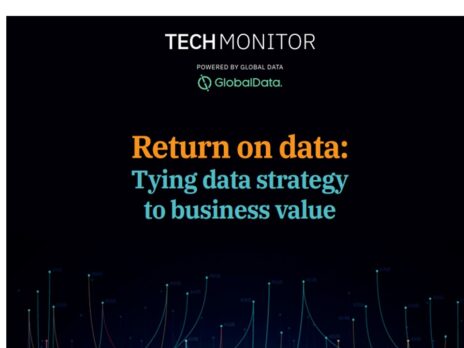
Over the past two years, the smart leveraging of data has become more vital to industry than ever before. Consumer trends – especially with regard to many businesses’ personalised customer offerings – have changed drastically, and, owing to ongoing supply chain issues, steep rises in inflation, and global conflict, stakeholders need all the available tools at their disposal.
Indeed, as Alteryx’s chief data and analytics officer, Alan Jacobson, points out: “Companies now understand what they need to do, but many still struggle with the how. They understand that they need to implement data in clever new ways and democratise analytics, but the know-how is not yet there for the majority of businesses.”

The survey
To get a picture of commonalities among organisations leveraging value from the data at their disposal, Tech Monitor surveyed more than 400 senior data and technology stakeholders from businesses based mainly in Northern Europe. Respondees to the ‘Return on data: tying data strategy to business value‘ survey were drawn from across a range of industries, with over half pulling in £400m or more in annual revenue.
Yet, according to Jacobson, just because a company is bigger in size or has more resources at its disposal, they do not necessarily have a better grasp of how to leverage data. Indeed, one of the report’s key findings is the discrepancy between what Alteryx refers to as ‘data value leaders’ and other businesses that do not leverage data in a consistent or effective way. For example, 54% of companies identified as ‘data value leaders’ said that they had a coherent long-term data strategy in place, while only 7% of other businesses could claim the same thing.
“Size isn’t the only thing that matters,” Jacobson says. “For example, if your company only has 20 people, you only need maybe five or ten of them to start using data analytics effectively in order to make a massive difference in the company. If you scale that up to a global company with 10,000 employees, it becomes a much bigger job.
“What smaller enterprises lack in size or resources or even in access to investment, they can make up for in terms of agility.”
But larger enterprises appear to be further along in their data journey. Of the respondents referred to in the report as ‘data value leaders’, Tech Monitor and Alteryx identified decision-makers from organisations in which “data is used extensively throughout the value creation process”. These companies represent more than a third of total respondents, and are more common among larger organisations based in the UK and Ireland than those from small to medium-sized enterprises based elsewhere in Northern Europe.
By extracting information from ‘data value leaders’ and comparing them against other organisations – distinguished within the report as ‘those who use data to create business value partially or not at all – a picture begins to emerge about the features, habits and working practises of organisations who are leveraging data successfully during a period of extreme global turmoil.
For example, for ‘data value leaders’ the democratisation of access to data knowledge is crucial, with 40% of operational staff having been trained to perform their own analysis of data to inform decisions. By contrast, in all other companies sampled, just 14% of respondents said that operational staff were able to perform the same tasks.
The report draws both on the results featured directly in the survey as well as from more in-depth interviews with senior data and technology executives. From this, business value creation can be measured at three levels: how data contributes to value creation and the importance of robust data strategy; how data and analytics capabilities should be managed and organised to create that value; and how democratising access and analytical capabilities contributes to value creation.
It should come as no surprise that the report ultimately concludes that ‘data value leaders’ are more strategic in their use of data, more likely to use it to manage risk, as well as more likely to profit from its leveraging.
‘Data value leaders’’ methods are more democratised, prioritise data-related initiatives as part of their businesses’ everyday practices, and are more likely to have embedded data expertise across departments. They are also more likely to democratise access to data among operational staff so that as many workers as possible across an organisation have the ability to perform their data analysis.
Jacobson uses the example of Netflix, which started as a relatively small business compared with larger competitors such as Blockbuster, but went on to corner the marketplace – not because it was better positioned financially, or because it had a more sophisticated data-leveraging strategy in place – but because it was agile enough to commit to using data to drive its business forward.
“Netflix beat Blockbuster not because Blockbuster didn’t have the data,” Jacobson says. “On the contrary, Blockbuster had all sorts of data about their customers: what shows they were watching, what movie they might want to watch next. And remember, this was in the 2000s, before the advent of streaming platforms across the board. The problem is that Blockbuster didn’t utilise its data effectively.
“There’s no reason another company couldn’t do what Netflix did to Blockbuster. All it takes is clever strategy, forward-thinking leadership, and a workforce hungry to learn the fundamentals of data. What puts people off is that change is hard. It’s not easy to transition away from manual processes if that’s all your workforce has ever known. The key is to put a programmatic change management approach in place to help people on the journey. It can actually happen incredibly fast, with staggering ROI occurring all along the way.”
The value of data
Though it will come as no surprise that data has the potential to create deep divides between organisations with the ability to fully harness its potential, and those that struggle to do so, the leveraging of data in particular is quickly leading to an enormous misalignment within industry at large.
Much of this, of course, has to do with overarching organisational strategy, though research also suggests that what organisations are crying out for is adequate training and support for individual employees in order to allow the democratisation and leveraging of data across departments.
As Jacobson points out: “The problem for businesses who aren’t succeeding is simply that we need more knowledge workers in the marketplace who are able to use data and analytics effectively. There’s really nothing more complicated than that when it comes to gaining competitive advantage within your industry, or even just making the process of automation as painless as it can be.
“The good news is that I think businesses are largely getting there. As with any move toward success, the first step is being aware that you have a problem. The next piece is reaching out to someone who knows what they’re doing – someone like Alteryx – who know have helped hundreds of companies on this journey, and not being afraid to ask for help.”
Indeed, for ‘data value leaders’ able to boast workforces which were not only armed with the latest technology, but with the freedom to facilitate the personal creation of solutions and the free use of data insight, there were clear financial differences between them and their competitors.
Many of these workers were able to utilise data for tax and accounting purposes, logistics, marketing, and the automation of laborious manual processes. Because this removes the need to waste time and which ultimately bolsters efficiency, workers are able to benefit from individual upskilling, boosting their value on the labour market, and engaging in more stimulating, quality work.








